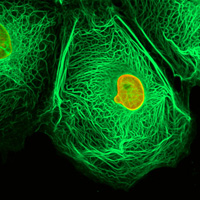


|
|
|
|
|
|
|
|
|
|
|
|
||||||||||||||
|
||||||||||||||
|
|
||||||||||||||
|
||||||||||||||
|
Posted 10/15/2007 Annual report finds cancer death rate decline doubling
The findings are in the "Annual Report to the Nation on the Status of Cancer, 1975-2004, Featuring Cancer in American Indians and Alaska Natives" published online Oct.15, 2007and appearing in the Nov. 15, 2007, issue of Cancer. A featured special section provides the most comprehensive cancer data to date for American Indians and Alaska Natives (AI/AN) across the United States. Cancer incidence rates among AI/AN men and women varied two-fold among six geographic regions of the country. From 1999 through 2004, AI/AN men from the Northern Plains region and AI/AN women from Alaska and the Northern and Southern Plains regions had higher cancer incidence rates than non-Hispanic white (NHW) men and women in the same areas. Among the general population, the report shows that long-term declines in cancer death rates continued through 2004 for both sexes and, despite overall higher death rates for men, the declines from 2002 through 2004 were 2.6 percent per year among men and 1.8 percent per year among women. Death rates decreased for the majority of the top 15 cancers in men and women. Important declines were noted for the three leading causes of cancer deaths in men: lung, prostate and colorectal cancers. In women, deaths rates from colorectal cancer and breast cancer decreased, while the rate of increase for lung cancer deaths slowed substantially. “The significant decline in cancer death rates demonstrates important progress in the fight against cancer that has been achieved through effective tobacco control, screening, early detection, and appropriate treatment," said Centers for Disease Control and Prevention Director, Dr. Julie L. Gerberding. “As a nation, we must commit to continuing and enhancing these important public health efforts.” “The evidence is unmistakable: we are truly turning the tide in the cancer battle,” said Dr. John R. Seffrin, chief executive officer of the American Cancer Society. “The gains could be even greater if everyone in the U.S. had access to essential healthcare, including primary care and prevention services.” Overall cancer incidence rates (the rates at which new cancers are diagnosed) for both sexes and all races combined declined slightly from 1992 through 2004. Incidence rates for female breast cancer dropped substantially from 2001 through 2004. This drop is possibly related to declining use of hormone replacement therapy as well as the recently reported decline in use of screening mammography. Also, lung cancer incidence rates in women stabilized from 1998 through 2004 after long term increases, and in men the rate declined 1.8 percent per year from the period 1991 through 2004. Colorectal cancer incidence rates decreased by more than 2.0 percent per year for men and women, likely due to prevention through the removal of precancerous polyps. In the Special Feature section of the Report, the authors found that while the top three cancers for men and for women are the same for AI/AN and NHW populations, there are important differences by region and type of cancer, including:
“We are firmly committed to addressing cancer health disparities so that the benefits of decades of research can reach all Americans,” said National Cancer Institute Director Dr. John E. Niederhuber. “The fact that lung and colorectal cancers rates were higher in some American Indian and Alaska Native populations points to the work we still have to do.” AI/AN populations were more likely to live in poverty and less likely to have a high school education and health coverage when compared to NHW persons, all indicators of less access to cancer prevention and control services. Also, current smoking rates were high among AI/AN overall, with the highest prevalence among AI/AN in Alaska and in the Northern Plains; in all regions, more AI/AN than NHW persons reported being obese; and screening rates for breast, colorectal, prostate and cervical cancers were lower among AI/AN than NHW persons. “We now have an infrastructure in this country for obtaining high-quality information about new cases of cancer and we can now describe the successes in cancer interventions and treatment as well as uncover populations with varying risks and outcomes,” said Holly L. Howe, Ph.D., executive director of North American Association of Central Cancer Registries (NAACCR). “Without this surveillance, we would be ill-equipped to address the challenges we face in further reducing the cancer burden.” The authors report that earlier detection of disease through screening, improved prognosis through more effective treatment, tobacco control, and reduction in inequalities in cancer care all point to the success of the nation’s dedication and focus on reducing the burden of cancer in the U.S. The study was conducted by scientists at the CDC, ACS, NCI, which is part of the National Institutes of Health, and NAACCR, in collaboration with scientists from the Indian Health Service and Mayo Clinic College of Medicine. |
| Columbia, SC 29208 • 803-777-7000 • sphweb@gwm.sc.edu | © University of South Carolina Board of Trustees |
 ATLANTA -- Death rates from
cancer have been dropping by an average of 2.1 percent a year
recently in the United States, a near doubling of decreases that began
in 1993, researchers say.
ATLANTA -- Death rates from
cancer have been dropping by an average of 2.1 percent a year
recently in the United States, a near doubling of decreases that began
in 1993, researchers say.